Climate Matters in Michigan
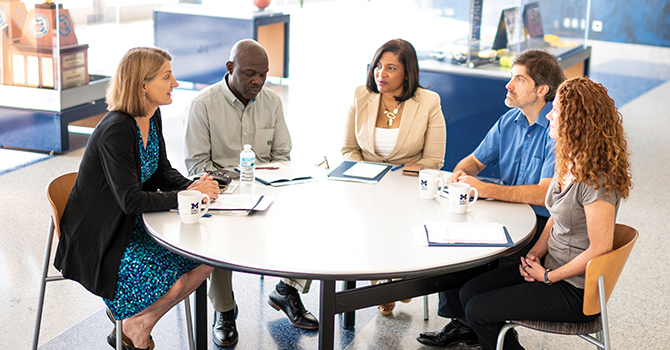
Pressing Realities for a State and a Region
Trish Koman, Zachary Rowe, Pamela Pugh, Shannon Brines, Paige Fischer
Nearly fifty years after the 1970 Teach-In on the Environment, which began with a rally in Crisler Center, we invited five colleagues to discuss what climate change will mean for the state of Michigan’s environment and its people. Gathered in Crisler’s Hall of Honor, they shared insights from their work and research in the region and their hopes and concerns for communities across the state.
Trish Koman, Research Investigator, Environmental Health Sciences, School of Public Health.
Zachary Rowe, Executive Director for Friends of Parkside & Founding Member, Detroit Community-Academic Urban Research Center.
Pamela Pugh, DrPH ’14, Chief Public Health Advisor for the City of Flint.
Shannon Brines, Applied Geographer, School for Environment and Sustainability.
Paige Fischer, Assistant Professor, School for Environment and Sustainability.
Koman. Climate change is already bringing an array of effects to Michigan. Air quality will change. We will see increases in heat-related illness. Vectorborne illness will change as mosquitoes and ticks bring to our state diseases we haven’t seen before or in higher numbers. Flooding is already a problem in Detroit and coastal communities. We’re seeing drought in other areas, challenges to food security—all of which will create new issues for Michigan. We know our public health community is strong and vibrant and can engage these issues on multiple levels. For this discussion, let’s begin with how cities in Michigan are mobilizing around climate change.
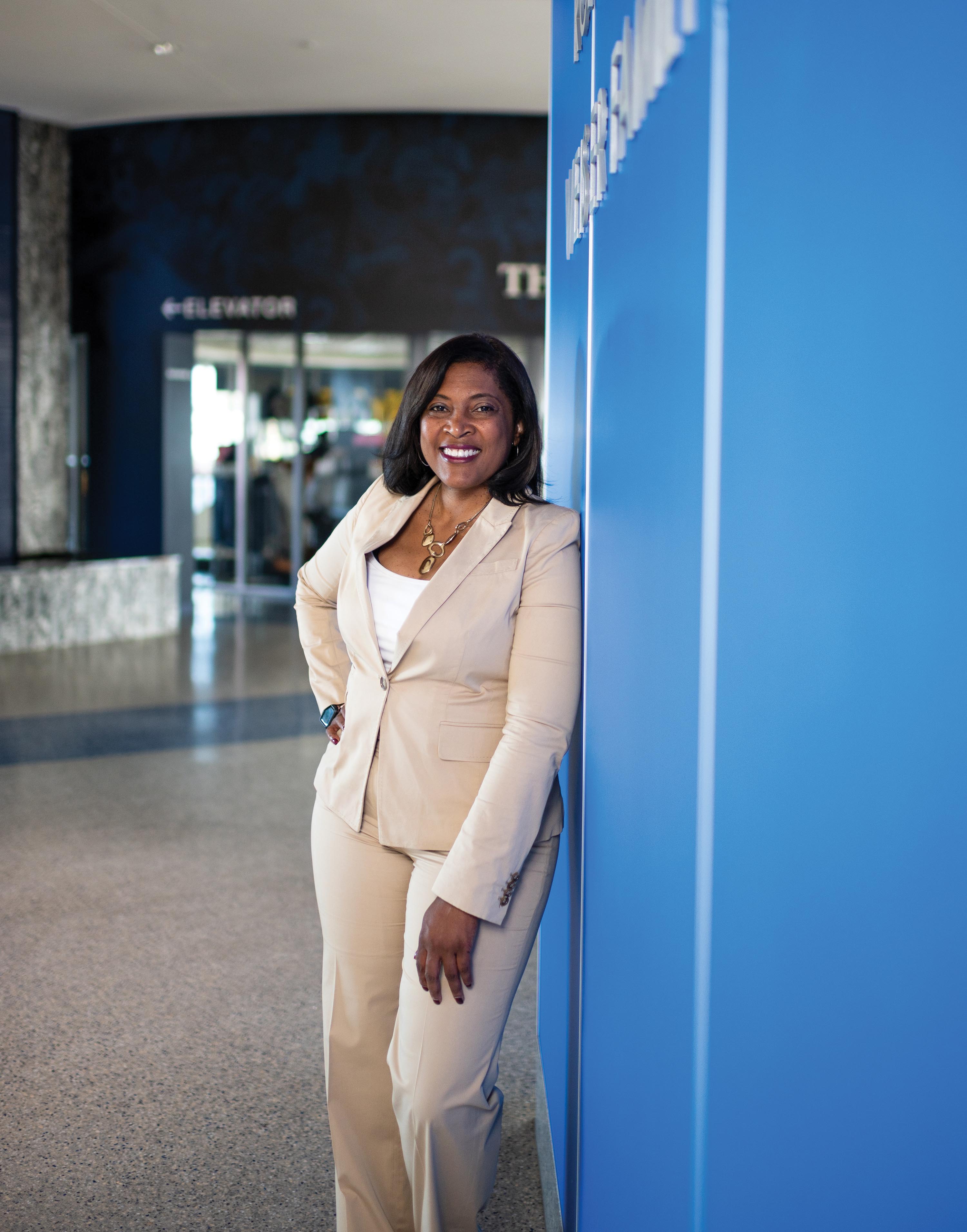
In Flint, we’re looking to help residents and businesses become part of the fastest
growing job market—solar and wind energy.”
–Pamela Pugh
Pugh. In Flint, we’ve been focused on the water crisis for the past five years. As we seek to address the high water rates residents face and an aging infrastructure, and in developing plans to replace home appliances damaged by corrosive water, we also look at strategies that promote efficiency. We’re rebuilding in more sustainable ways. Flint Mayor Karen Weaver created the Chief Public Health Advisor role to ensure all public departments in Flint work together more efficiently. As we know, systems that reduce energy use and costs also help us move away from older energy sources. We’re looking to help residents and businesses become part of the fastest growing job market—solar and wind energy. The city’s master plan entails social equity and sustainable planning in all goals and calls for an increase in rain gardens, storm-water management, and solar development.
Rowe. The city of Detroit has taken big steps in putting together a plan, including creating an Office of Sustainability. City government has taken a strong and effective leadership position on climate change. The thing about strong leadership is that you need followers. Climate change is huge, and we don’t always know how to get our arms around it. When I talk to folks in my community trying to provide for their families and pay their bills about this thing on the horizon called climate change—it is easy to push it out to the future.
At Friends of Parkside, in partnership with the city, we help translate how we make these large issues relevant to people’s daily lives. In the Detroit URC heatwave study, we looked at the impact of heat in homes. Being involved in the heatwaves study—where you are not only a participant but have access to the science itself—gives us that context. And the science tells us that we’re right. Those days you thought were not only extremely hot but unusually hot—that is part of global warming. Those insights are important in helping people change behavior. It’s easier to get entire communities moving toward new behaviors and new policy when they know they’re part of something bigger and that they’re not alone.
Brines. Many of the things we discuss in urban areas also affect rural landscapes, including the people living on those landscapes. Rural areas produce much of the food we consume, and the reality is that climate change is already happening. Growing seasons are in flux. Farmers are used to seasonality and annual variation but are seeing new extremes. Our food systems need diversity, and our farmers need diversity in their operations as a central part of their strategy for enduring and surviving variations and continuing to produce the food we depend on. The early rain this season was particularly hard for farmers using an industrial-commodity model—rotating through cash crops like soy and corn—because it delayed or even prevented planting.
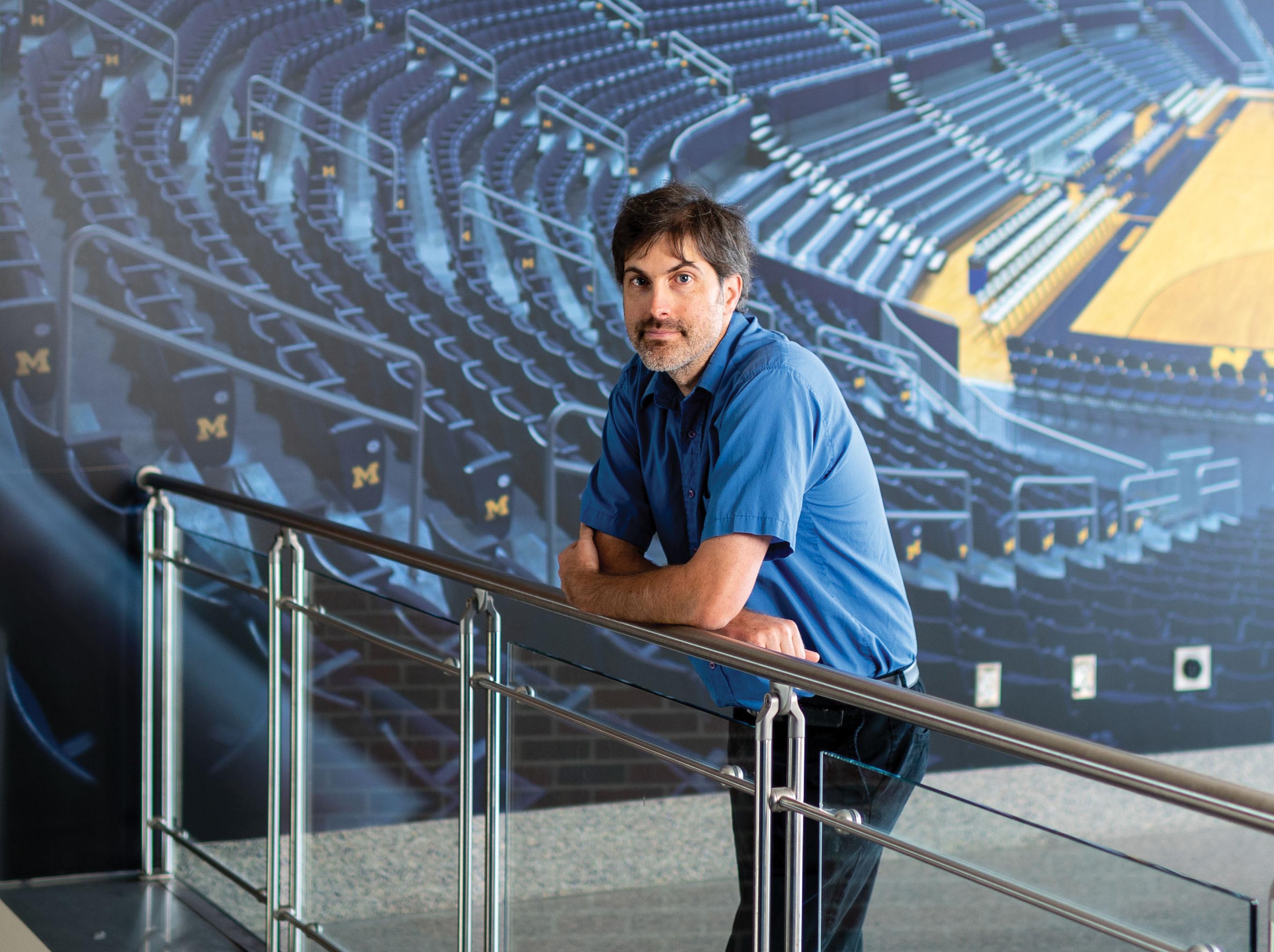
We often focus on production, but we need to look closely at the ways a farm stewards its landscape.”
–Shannon Brines
I want to challenge folks to rethink our models. Incorporating more diverse crops and planting methods is part of a larger movement toward farming in the way of nature—mimicking natural processes by integrating variety into agricultural practice. A major step all farmers can take is to use more perennial-based systems, using crops that produce each year without replanting. A small percentage of farms use cover crops, but generally, we don’t utilize the sun and rain at the ends of seasons that hit our fields. Perennials can be integrated into most farming systems. We often focus on production, but we need to look closely at the ways a farm stewards its landscape.
Fischer. Right, these shifts in mindset and in behaviors are so important, especially for communities whose lives depend on land-use production. I take students to the Leelanau Peninsula in northwest Michigan, where fruit producers have experienced two once-in-a-lifetime devastating crop losses within 12 years of each other. Huge economic damages are associated with that along with food supply disruption. It can cause psychological damage when your economy, your social fabric, your livelihoods are bound up in being able to produce a crop reliably every year and then that changes. Complete losses like this can undermine an entire community. On the field trip, the public health students helped focus us on this, asking how people deal with the stress of uncertainty and loss as a result of climate change and what this does to mental health.
Pugh. And on the other side of our food systems and food insecurity concerns are consumers in vulnerable communities—including black-brown, low-income communities. The lead crisis led us to focus on providing children with more nutritious food, educating parents about healthier food choices. But on the policy side, access to nutritious food is lacking. When changing weather patterns make it that much more difficult to produce healthy food, vulnerable communities will need policy support to adjust to an already inequitable situation. We can’t tell people to eat better without ensuring they have access to healthy foods and giving them tools to understand how this will move us toward more just systems.
Koman. Studies across Michigan show that people of color and lower-income communities experience more of the factors that contribute to negative health effects. How do we address this moving forward as so many systems are changing?
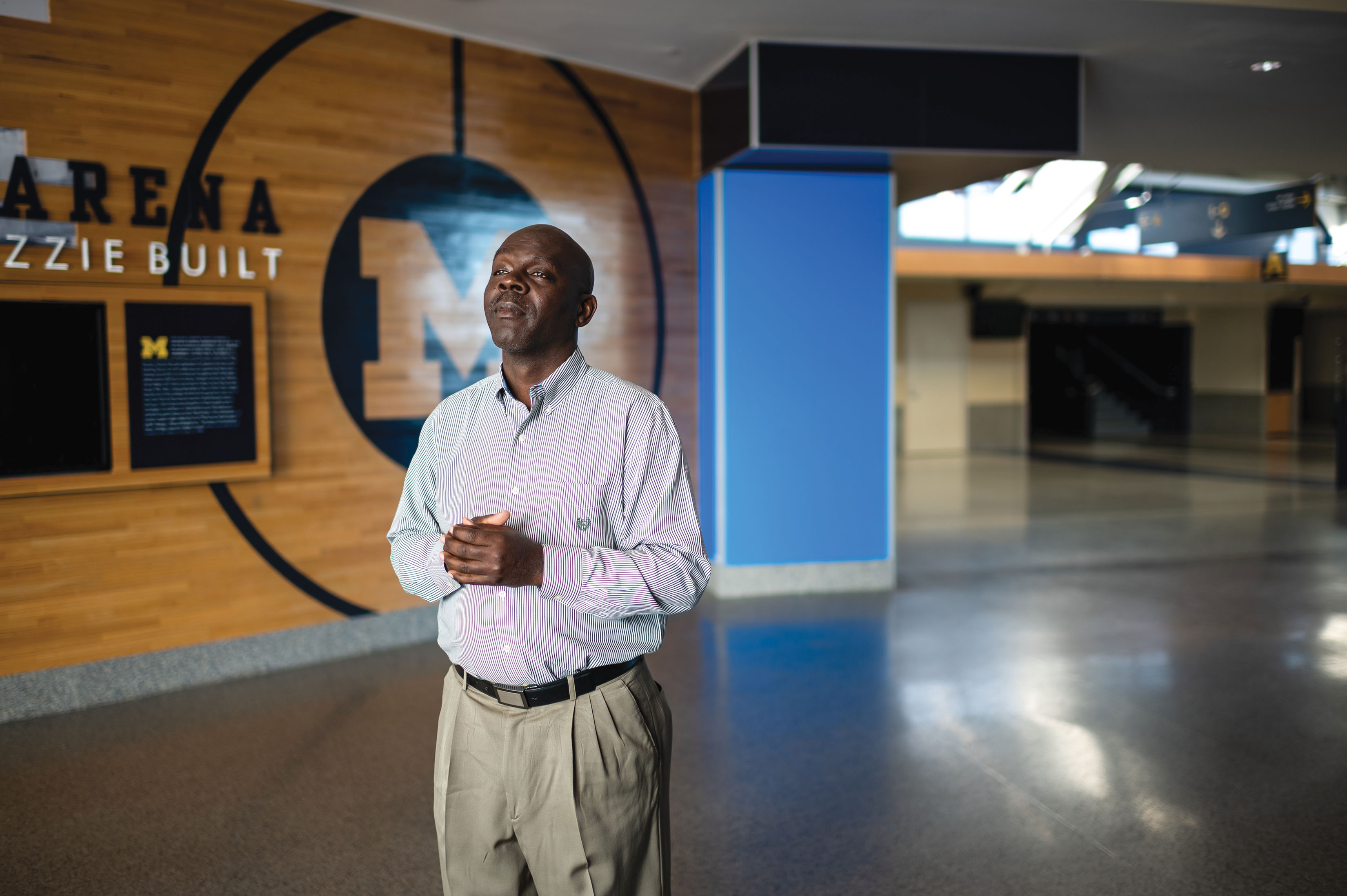
Moving forward, we have to talk not only about economic and environmental impacts but health impacts.”
–Zachary Rowe
Rowe. With large projects like the Gordie Howe International Bridge and Fiat-Chrysler plant, Detroit is experiencing a comeback in many ways. Policymakers calculate economic impact quickly so it translates to jobs and taxes. Communities push for environmental impact assessments. But we don’t always have the full picture of the health impacts of projects. Moving forward, we have to talk not only about economic and environmental impacts but health impacts. In talking about policy, we need more community input on how the built environment is experienced.
Koman. So true. Many people think the world around us is a given. We think it has always been and always will be like this. But development can change things quickly, and climate change will too. The CO2 we emit now will stay in the atmosphere for a long time—the concentrations stay for 50 to 1,000 years.
When I worked on water-quality education with community groups in Flint, we talked about the corroded pipes, which had been installed so long ago people couldn’t remember when they’d been put in—now suddenly these pipes were a problem. As the community replaced lead pipes, we talked about how upgrades they make now to their built environment—the water delivery system and beyond—would affect people years from now. Someone in Flint in 50 years will either bless them or curse them for the way they made these changes.
This responsibility gave the residents an opportunity to ask what community they wanted, how to shape that community, and so on. Michigan is at this point now with climate change. The choices we make now will be with us for a long time.
Pugh. I want to observe that you said “someone in Flint.” Someone is always making the policy decisions now that will impact us for generations. That is why our electoral process is huge as we talk about this. When a municipality receives funds, we want to move quickly. In those moments we need knowledgeable, courageous people to say, “Wait, let’s pause on this, because it will impact us for generations to come.” The policymakers we elect must be bold and wise enough to think about the long term. Too often these decisions are made in haste without nearly enough thought of tomorrow.
Koman. That is a challenge for public health, to make the case for future benefits and to make the case for health in all policies—that health should be a value at the center of all public decisions. As a geographer, Shannon, what are your thoughts on the scale at which we consider climate impacts? Many climate models do not include the Great Lakes because they are not at a big enough scale to impact modeling. On the other hand, if we look too narrowly, we might miss important insights. For example, the Southwest and other drought-prone areas of the US look at the Great Lakes as a national water source.
Brines. We are indeed a water resource others are looking at. It seems ironic that Michigan farms, surrounded by these large lakes, could become stressed for water. It reminds us that many things will be out of the control of individual farmers and citizens. Farmers should think about how they can create self-sustaining systems on their own landscape, how they can survive and thrive with resources on their land and not count on external sources.
If farmers are moving water off their landscapes in the spring so they can plant with heavy equipment and then need water later in the season, perhaps we should retain that water somehow. Doing so would also reduce harmful algal blooms in some watersheds, like the one that shut down Toledo’s water system. It’s another example of the urban-rural connection, a public health problem in an urban center related to agricultural systems in the surrounding area. We need to think on much larger scales as we redesign landscapes.
Rowe. Our work on the heatwave project—a three-city project in Atlanta, Phoenix, and Detroit —is another example of seeing things on larger scales. Participants agreed to install a variety of home-monitoring devices in their homes and yards and to wear monitors at certain times. It gave us a full picture of what homeowners experience and let us share with them how hot they were during heatwaves compared to other communities. People assume the heat they experience is normal across the city. But citywide data—average heat in other homes when their home might be registering 80 or 90 inside—told another story.
The data helped us document the health effects of living in units built to have central air that suddenly didn’t have it, and we used this information to advocate for local policy change. In talking to people in the study, an issue like heat becomes real. People don’t talk about extreme-heat events as part of something larger, they just talk about it as the weather—nothing you can do about it. People involved in this study opened their eyes to something bigger going on.
Pugh. Interesting. Communication is a big part of building more resilient communities. When the water crisis first came on the scene, the Flint planning and development team was already working on something called the Imagine Flint plan. They quickly adapted that focus almost exclusively for the water crisis. Now we are moving back to those broader plans and thinking forward with residents toward growth even as we continue to address the water crisis.
We continue to learn how best to communicate all of this with residents, how to build effective emergency systems. The city is working on systems that help us disseminate information more quickly to the entire population in emergencies. We regularly convene representatives from medicine, research, planning and development, our recovery office, and our county health department to improve communication between leadership units and with residents.
Rowe. We’ve heard a lot about the Flint Water Crisis. Pamela, I’m amazed at what the city has done with that word crisis. I know from some of our community partners in Flint that you have changed the narrative from water crisis to water opportunity. You look at every dollar coming into the city as a dollar that can have long-term impact. The city’s leadership isn’t looking one or five years down the road but 20, 30 years down the road and thinking about what it means to shape Flint for the future. For a time, the word crisis was appropriate. Now folks across the community are looking around the city for every opportunity to get things done today and for generations to come. I’ve been amazed. Sadly, there will be another situation like the water crisis, and it will be important for Michigan communities to feel resourced and empowered to address whatever arises.
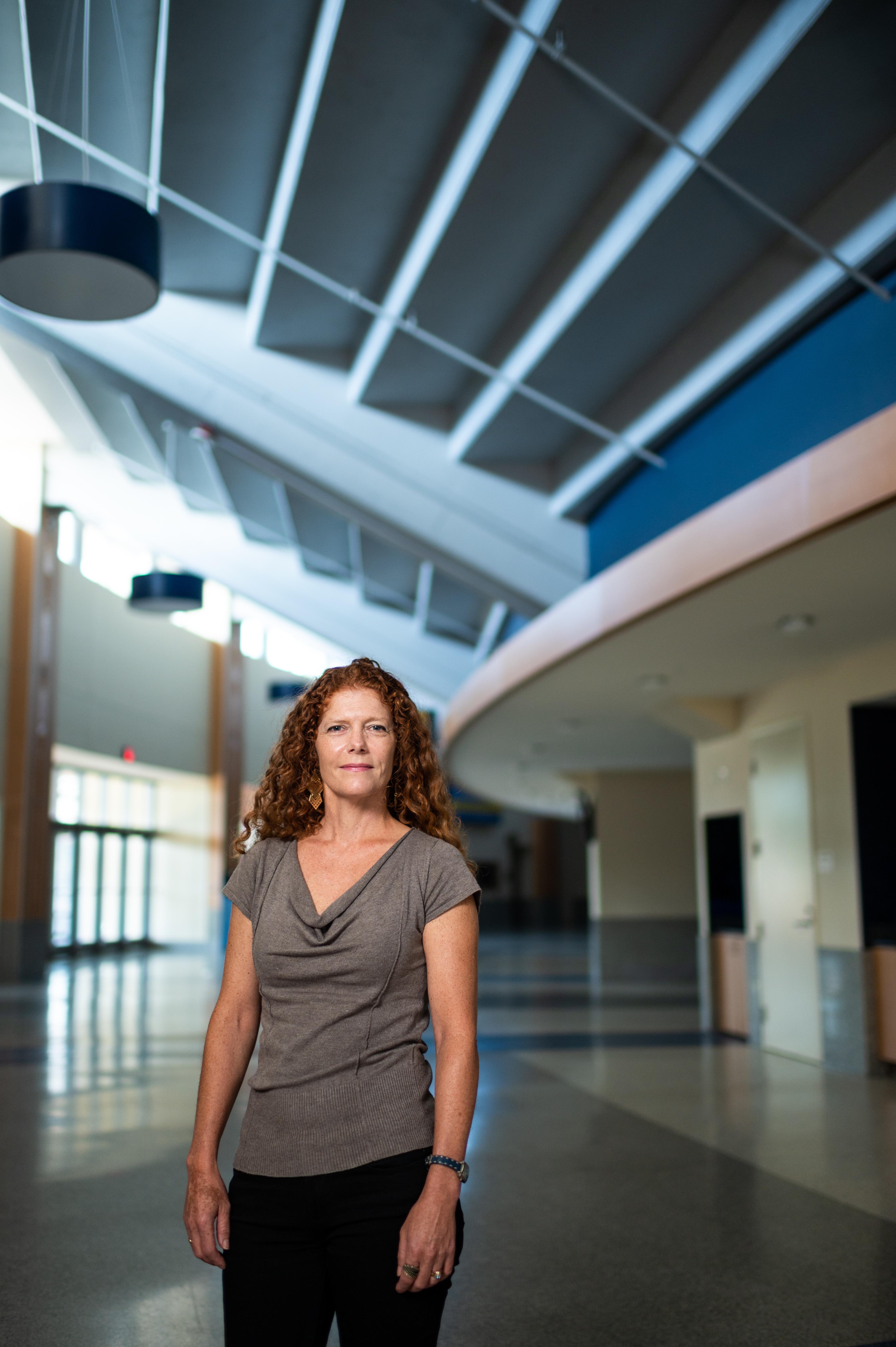
The solution is creating processes where people affected by climate change are at the table with people who have access to information and who have influence over decision-making.”
—Paige Fischer
Fischer. Empowerment is so important in all of this. Empowerment happens on many levels—for climate change and population health, empowerment develops on large scales. Empowerment is influenced by large structural forces like markets, policies, and political processes. But it also relates to these questions about scale and how local communities can respond to climate change effectively. As individuals, we relate to our environment often on small, local scales. The climate-driven changes occurring are at large scales and usually over long periods of time. Average temperature changes happen slowly. The frequency and severity of notable weather events is increasing slowly and with variability. It is hard for an individual to know what’s normal.
This concept is psychological distance—the difficulty for people to feel knowledgeable and empowered to take action about something happening in a distant place or a distant period of time or that’s happening in our community but in ways we can’t perceive or to people we don’t know or relate to. It’s a lot to expect individuals to take it upon themselves to act to mitigate climate change or respond to policies. The solution is creating processes—like participatory research or participatory community planning—where people affected by climate change are at the table with people who have access to information and who have influence over decision-making. Together, we can discuss the changes we are experiencing and what we can do.
In my work around wildfires, we look not only at the immediate human health impacts—for example, the smoke that carries airborne particulate matter and noxious gases that create so many adverse human health effects. We also look at how wildfire and even just the threat of wildfire can cause extreme stress for people at risk of losing life and property. Slowing climate change, which will impact the severity of wildfires, will have public health benefits, and now is the time to empower people to act.
Koman. Air pollution is a good example of how we’ve acted—how we’ve solved a major problem. I think about my grandfather, who lived in Niagara Falls, New York, and worked as a millwright. The sulfur emissions near the paper mills were overwhelming.
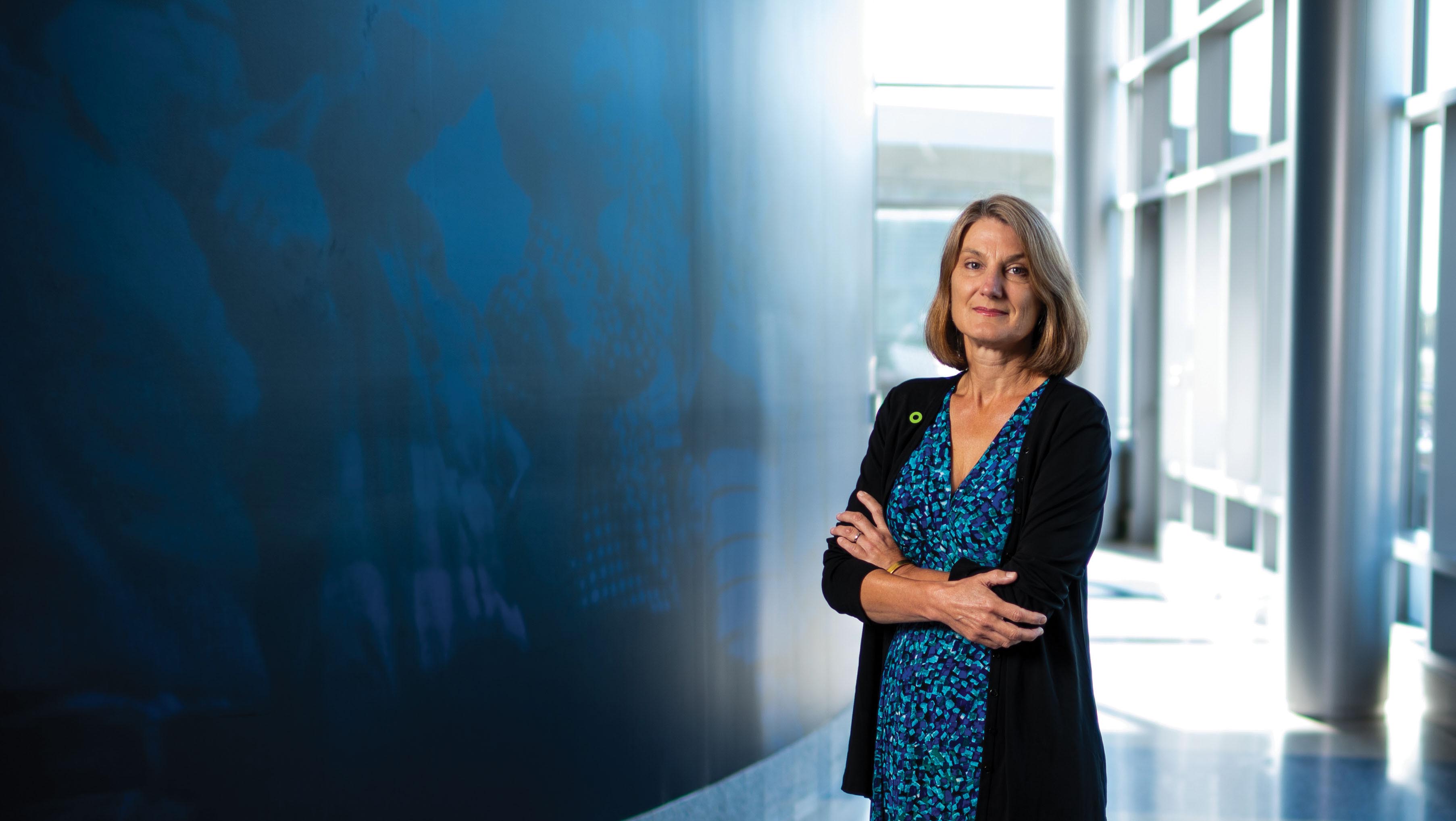
We’ve made incredible progress in air quality. Climate change is bigger, but we know we can make significant shifts.”
–Trish Koman
Today, with the Clean Air Act, no one in the US has to live in a community like that. We’ve made incredible progress in air quality. Climate change is bigger, but we know we can make significant shifts. In Michigan, our auto industry is already meeting tough standards and promises to continue meeting them. As we discussed, mitigating climate change actually presents economic opportunities. In 2001, researchers projected that solar power would grow at one gigawatt per year, and we’ve exceeded that by 75 times. The energy sector is evolving, and Michigan has expertise in these industries.
Pugh. In prioritizing environmental justice, we are discussing the installation of solar in low-income communities and communities of color, like Flint, which we refer to as just energy—remembering that $41 billion was spent in 2009 alone by communities of color on energy costs while benefiting from only 1 percent of energy-related jobs. These communities want to move into solar and wind energy—for the economic benefits and to get the health benefits of bringing these renewable energy sources to our region. And we know these changes address climate change in a positive way.
Brines. Technology is also important in agriculture. The Land Institute in Kansas receives a lot of press with Kernza, a perennial wheat crop. Fruits and vegetable growers have always bred for hardiness and resistance and are now looking to develop varieties that seem particularly resilient to various climate change realities. Common technologies like the internet help land stewards connect and learn from each other. Many agricultural methods are still quite old, but we need new ways of teaching them as we retrain farmers in more sustainable practices and train new people to steward our lands.
Koman. There are so many positive things related to more sustainable approaches.
What are some hopeful changes you want to see or are seeing?
Pugh. We have to keep economic justice at the center of our discussions. Earning power in vulnerable communities is also a huge health benefit. Having access to a job impacts health. In moving toward renewable sources of energy, we must also address health. In addressing climate change in an urgent way, we can also take the opportunity to address other urgent issues that are intertwined with climate and environment. The ability to introduce urgency to multiple justice issues at once gives me hope that we can implement change.
Rowe. It makes me hopeful that we’re having a discussion around climate change. Young people are concerned about and talking about climate. I can see just how carefully they are learning and listening, and that gives me hope. These ideas will take root, and new generations will come up with solutions, amazing solutions to some of the problems we are facing.
Brines. Participatory projects give me hope—when university groups work with and really learn from local communities. It gets us reengaged and offering an extension-type model, which is valuable to farmers and academics alike. Farmers want to feel good about what they do, what they grow, and we need to support them.
Fischer. More people now recognize that what we’re experiencing is climate change—people from across the political spectrum and from all walks of life. I’m conducting a study of rural forestland owners—historically a conservative group—who refer to their climate change experiences without any prompting from us. They bring it up on their own. It gives me hope that people are starting climate change discussions on their own.
Koman. The fact that there is scientific consensus that climate change is real, that it is happening now, that we’re causing it, and that we can prevent it gives me hope. I know that public health professionals are excellent in this space, where there is a big challenge, scientific evidence, something difficult that has to be talked about, and solutions are widespread. That is where public health professionals do their best. We all play a role in climate change, and together we can prevent the worst health outcomes. We know we can reduce emissions and reverse course, and the question now is, will we? I think the answer to that is, absolutely.
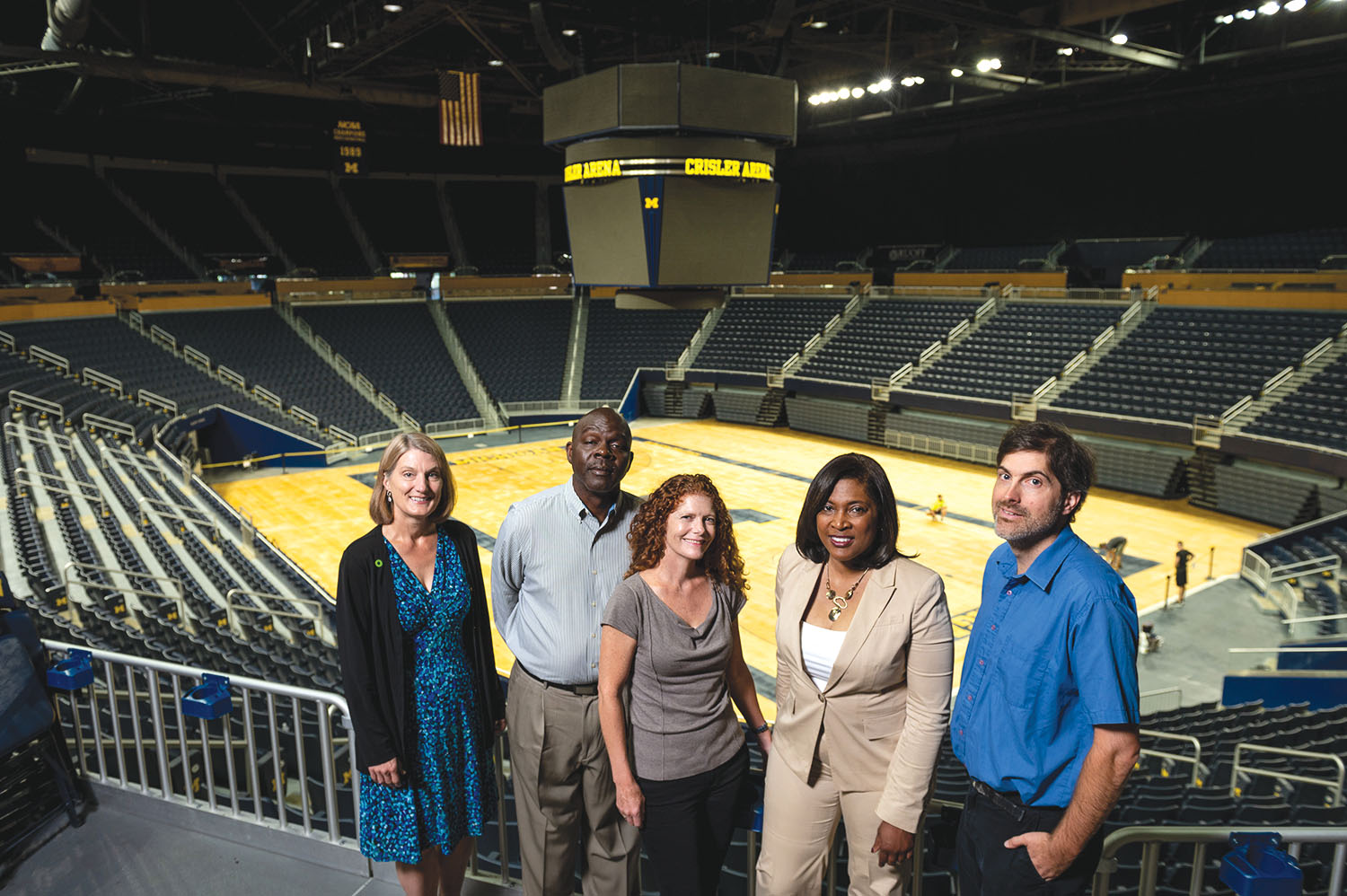
[Photography by Eric Bronson - Michigan Photography]
This article is based on a group discussion held at Crisler Center on August 9, 2019, and has been edited for brevity and clarity.
ABOUT THE CONTRIBUTORS
Trish Koman is a Research Investigator in Environmental Health Sciences at the School of Public Health and a Program Manager in the College of Engineering’s Multidisciplinary Design Program. Her research focuses on air and water quality health impacts among vulnerable populations, including those affected by wildland fire, and she is leading an analytic team for the President’s Commission on Carbon Neutrality.
Zachary Rowe is Executive Director for Friends of Parkside, a community-based nonprofit in Detroit, and a founding member of the Detroit Community-Academic Urban Research Center (Detroit URC), which is housed within the School of Public Health. He has worked on the Heatwaves, Housing, and Health and the Detroit Communities Reducing Energy and Water use (DCREW) research projects.
Pamela Pugh, DrPH ’14, serves as Chief Public Health Advisor for the City of Flint, advising city officials and residents on the impacts of policy on the population’s health. Her doctoral research focused on childhood lead poisoning and other neighborhood health factors. She now works closely with state and federal government to translate and interpret science for the public.
Shannon Brines is an Applied Geographer at the School for Environment and Sustainability, supporting the integration of spatial analysis into research and learning. He has collaborated with School of Public Health researchers on projects evaluating the built environment’s impact on human health. He is a farmer in Washtenaw County using sustainable agricultural practices.
Paige Fischer is Assistant Professor at the School for Environment and Sustainability. Her teaching and research focus on human behavior, especially how people experience and respond to environmental changes. Much of her work is on forest management systems, and before coming to academia she worked for the US Forest Service.
